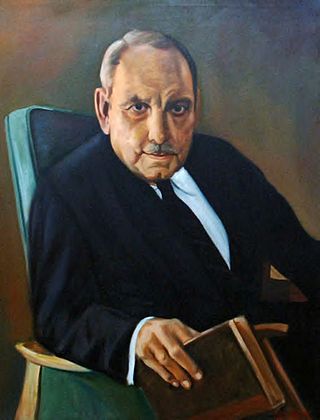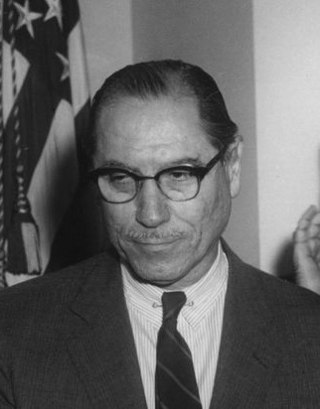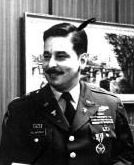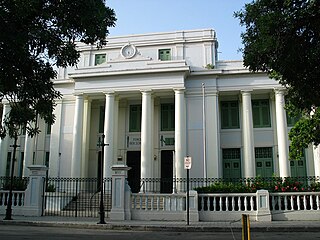
José Luis Alberto Muñoz Marín was a Puerto Rican journalist, politician, statesman and was the first elected governor of Puerto Rico, regarded as the "Architect of the Puerto Rico Commonwealth."

Roberto Sánchez Vilella was the governor of Puerto Rico from 1965 to 1969. Sánchez Vilella successfully ran for governor in the 1964 elections for the Partido Popular Democrático. He is also the founder of the People's Party, "Partido del Pueblo", also known as el Partido del Sol.

The following is an alphabetical list of articles related to the Commonwealth of Puerto Rico.

Luis Muñoz Rivera was a Puerto Rican poet, journalist and politician. He was a major figure in the struggle for political autonomy of Puerto Rico in union with Spain.

José Teodoro Moscoso Mora, was a Puerto Rican businessman and politician known as "the architect of Operation Bootstrap".

Antonio Rafael Barceló y Martínez was a Puerto Rican lawyer, businessman and the patriarch of what was to become one of Puerto Rico's most prominent political families. Barceló, who in 1917 became the first President of the Senate of Puerto Rico, played an instrumental role in the introduction and passage of legislation which permitted the realization of the School of Tropical Medicine and the construction of a Capitol building in Puerto Rico.
Education in Puerto Rico is overseen by the Department of Education of Puerto Rico and the Puerto Rico Education Council. The Department oversees all elementary and secondary public education while the Council oversees all academic standards and issues licenses to educational institutions wishing to operate or establish themselves in Puerto Rico.

The Capitol of Puerto Rico, also known as Casa de las Leyes(House of Laws), and most commonly referred to as El Capitolio(The Capitol), is the seat of the Legislative Assembly, or the bicameral legislature, composed of the Senate and House of Representatives, responsible for the legislative branch of the government of Puerto Rico. Located on San Juan Islet immediately outside the Walls of Old San Juan, the oceanfront, neoclassical Beaux-Arts-style, entirely white marble-covered edifice was constructed between 1921 and 1929 to resemble the ancient Roman Pantheon in Rome, using as inspiration the Low Memorial Library in New York City. It was added to the National Register of Historic Places in 1977.

Raúl G. Villaronga was a United States Army officer who was the first Puerto Rican mayor of a Texas city. He served as mayor of Killeen, Texas, for three consecutive terms, from 1992 to 1998.
Dr. José Nicolás Gándara Cartagena was a Puerto Rican physician and public servant. He led medical personnel in the treatment of the hundreds of wounded of the Ponce massacre that occurred on Palm Sunday, 1937, in Ponce, Puerto Rico, at the hands of the Insular Police, under orders of the American colonial governor Blanton Winship. He also provided expert witness testimony regarding the Puerto Rican Nationalists victims being shot on their backs while they ran away from the police, and that many were wounded by the police using their clubs and bare fists.

The Ponce High School is public educational institution in Ponce, Puerto Rico, offering grades nine through twelve. The school's main building is a historic structure located on Cristina Street, in the Ponce Historic Zone. From its beginning the school has secured a unique place in Puerto Rico's educational history. Of over 3,000 schools erected in Puerto Rico in the first quarter of the twentieth century, Ponce High was the largest, "at a time enrolling more students than all the other Puerto Rico high schools combined", and for many years enrolling more students than any other high school in Puerto Rico. The cost of the building in 1915 dollars was $150,000 USD. The building was listed on the U.S. National Register of Historic Places on 4 August 1987. The school has the only diamond-level DECA chapter in Puerto Rico. The Ponce High School building is "among the most important public buildings ever built in Puerto Rico." The school is the oldest continuously-operating high school in Puerto Rico.

María Teresa Babín Cortés was a Puerto Rican educator, literary critic, and essayist. She also wrote poetry and plays. Among her best-known works is Panorama de la Cultura Puertorriqueña and several essays on Federico García Lorca.

The Popular Democratic Party is a political party in Puerto Rico that advocates to continue as a Commonwealth of the United States with self-governance. The party was founded in 1938 by dissidents from the Puerto Rican Liberal Party and the Unionist Party and originally promoted policies on the center-left. In recent years, however, its leaders have described the party as centrist.
Villaronga is a surname. Notable people with the surname include:

La Democracia, founded on 1 July 1890, was a news daily published by Luis Muñoz Rivera in Ponce, Puerto Rico. It crusaded for Puerto Rican self-government. At a publication length of 58 years, it was the longest continuously-running Puerto Rican Spanish newspaper of its time, and one of the longest continuously running Puerto Rican newspapers of all time.
Rafael Ríos Rey was a Puerto Rican muralist. He is credited with being the first Puerto Rican muralist whose work received international recognition.

Luis Muñoz Rivera is a statue to the memory of Puerto Rican poet, journalist and politician Luis Muñoz Rivera located at Plaza Luis Muñoz Rivera in Ponce, Puerto Rico. The statue is in bronze. The statue's large marble pedestal follows in the Beaux Arts architectural tradition.
The Puerto Rican Division of Community Education was an agency established in 1949 with the purpose of producing cultural materials for public education on the island of Puerto Rico. Local writers, artists, community organizers, filmmakers and musicians were employed by DIVEDCO to create works and programs in their respective fields on topics of public interest such as literacy, health care, democracy and civic engagement. The agency was a product of the Popular Democratic Party of Puerto Rico under Luis Muñoz Marín following the party’s rise to power during the 1948 elections. Rural and poor citizens with limited access to public resources were the primary target audience of DIVEDCO, although their cultural products had widespread impact on Puerto Rican society and culture broadly. DIVEDCO was most active between the 1950s and the 1970s. The agency halted production around 1989.

This second government of Governor of Puerto Rico Luis Muñoz Marín followed his reelection after the enactment of the 1952 Commonwealth Constitution. In many ways it was a continuation of the previous government, with some changes in key positions such as the Secretary of Justice, and decreased control of the Senate of Puerto Rico and House of Representatives of Puerto Rico by virtue of the expansion of the Legislative Assembly's chambers and the effects of Article III, Section 7 of the Constitution of Puerto Rico (1952).












